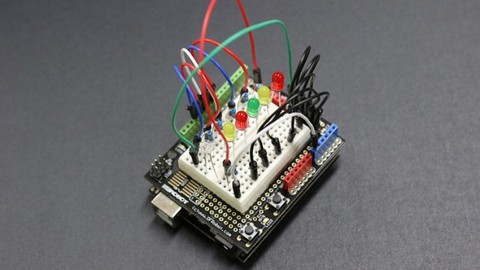
Embedded System Design using AVR Microcontroller (ATmega 32)
Embedded System Design using AVR Microcontroller (ATmega 32), available at $44.99, has an average rating of 5, with 100 lectures, 13 quizzes, based on 1 reviews, and has 9 subscribers.
You will learn about Basics of AVR Microcontroller Architecture of AVR Microcontroller Pin Diagram of AVR Microcontroller Instruction set of of AVR Microcontroller Directives and Addressing modes of AVR Microcontroller Assembly Language Programming of AVR Microcontroller IO Programming of AVR Microcontroller EEPROM Programming of AVR Microcontroller Stack, Subroutine and Macro concepts of AVR Microcontroller Embedded C Programming of AVR Microcontroller Timer Counter Basics and Programming of AVR Microcontroller Interrupts AVR Microcontroller Serial Communication of AVR Microcontroller LCD and Keyboard Interfacing with AVR Microcontroller DC and Stepper Motor Interfacing with AVR Microcontroller ADC Basics and Programming SPI and I2C Serial Communication Protocols DS 1307 RTC Interfacing Commonly used serial Communication Protocols This course is ideal for individuals who are Embedded Systems Engineers or Hardware Engineers or Students (Engineering, Diploma, Science) or Tech Enthusiasts or Those who want enter into the field of Microcontroller It is particularly useful for Embedded Systems Engineers or Hardware Engineers or Students (Engineering, Diploma, Science) or Tech Enthusiasts or Those who want enter into the field of Microcontroller.
Enroll now: Embedded System Design using AVR Microcontroller (ATmega 32)
Summary
Title: Embedded System Design using AVR Microcontroller (ATmega 32)
Price: $44.99
Average Rating: 5
Number of Lectures: 100
Number of Quizzes: 13
Number of Published Lectures: 100
Number of Published Quizzes: 13
Number of Curriculum Items: 113
Number of Published Curriculum Objects: 113
Original Price: ₹2,999
Quality Status: approved
Status: Live
What You Will Learn
- Basics of AVR Microcontroller
- Architecture of AVR Microcontroller
- Pin Diagram of AVR Microcontroller
- Instruction set of of AVR Microcontroller
- Directives and Addressing modes of AVR Microcontroller
- Assembly Language Programming of AVR Microcontroller
- IO Programming of AVR Microcontroller
- EEPROM Programming of AVR Microcontroller
- Stack, Subroutine and Macro concepts of AVR Microcontroller
- Embedded C Programming of AVR Microcontroller
- Timer Counter Basics and Programming of AVR Microcontroller
- Interrupts AVR Microcontroller
- Serial Communication of AVR Microcontroller
- LCD and Keyboard Interfacing with AVR Microcontroller
- DC and Stepper Motor Interfacing with AVR Microcontroller
- ADC Basics and Programming
- SPI and I2C Serial Communication Protocols
- DS 1307 RTC Interfacing
- Commonly used serial Communication Protocols
Who Should Attend
- Embedded Systems Engineers
- Hardware Engineers
- Students (Engineering, Diploma, Science)
- Tech Enthusiasts
- Those who want enter into the field of Microcontroller
Target Audiences
- Embedded Systems Engineers
- Hardware Engineers
- Students (Engineering, Diploma, Science)
- Tech Enthusiasts
- Those who want enter into the field of Microcontroller
This Embedded System Design Course with AVR Microcontroller is specially designed for engineering students who want to enter the field of Embedded Systems and is also useful for working professionals. This Embedded System Designis a unique course in the online marketplace.
Prof. Hitesh Dholakiya is an Electronics and Communication Design Engineerwith over 15 years of experience in the core Electronics/Electrical domain as well as in the Antenna/RF/Communication field. He has taught many subjects related to microprocessors and Embedded systems during his tenure of teaching. With a passion for teaching and a wealth of industry knowledge, Prof. Hitesh Dholakiya is dedicated to helping students achieve their academic and professional goals in the Embedded System Designdomain.
Students must have in-depth knowledge of any microcontroller to start the embedded journey and this course on Embedded System Designdrives you from basic to advanced level concepts which enables you to deal with any microcontroller in the future.
Students should know the basic C for this Embedded System Designcourse and this course covers both assembly and C aspects of programming, as well as students, are also going to learn software and hardware tools for programming.
The practical part of this Embedded System Design using AVR microcontrollercoursecovers performance on both simulations as well as on the Hardware kit.
The following chapters are covered in this course on Embedded System Design using AVR microcontroller
1. Introduction to AVR Microcontroller
2. Architecture and Pin Diagram of AVR Microcontroller
3. Instruction Set and Directives of AVR Microcontroller
4. AVR Microcontroller IO Basics and Programming
5. AVR fuse bits and AVR Programming Methods
6. EEPROM Programming of AVR Microcontroller
7. Stack, Subroutine, and MACRO Concepts of AVR Microcontroller
8. AVR Microcontroller Timer/Counter Basics and Programming in Assembly and C
9. Interrupts of AVR Microcontroller
10. AVR Serial Communication:
11. LCD Interfacing with ATmega32 AVR Microcontroller
12. 4 X 4 Keyboard Matrix Interfacing with ATmega32 AVR Microcontroller
13. DC Motor Interfacing with ATmega32 AVR Microcontroller:
14. Stepper Motor Interfacing with ATmega32 AVR Microcontroller
15. Analog to Digital Converter
16. SPI Serial Communication Protocol of AVR Microcontroller
17. I2C (TWI) Serial Communication Protocol
18. DS 1307 RTC Interfacing with AVR Microcontroller and its Programming
19. Serial Communication Protocols
20. AVR Microcontroller Practicals with Proteus Simulation and Demo on Hardware kit
Topic wise Detailed Syllabus of Embedded System Design using AVR microcontrollercourse is as follows:
1. Introduction to AVR Microcontroller: Introduction to Microcontroller and Microprocessor, Harvard and Von Neumann Architecture, RISC Features in AVR Controller and RISC and CISC comparison, Introduction to AVR Microcontroller, Pipelining in AVR Microcontroller.
2. Architecture and Pin Diagram of AVR Microcontroller:RAM and ROM Architecture of ATmega32, Architecture of AVR Microcontroller, Pin Diagram of ATmega32 AVR Microcontroller, Status Register of ATmega32 Microcontroller.
3. Instruction Set and Directives of AVR Microcontroller:Data Formats and Directives in AVR Microcontroller, Arithmetic Instructions in AVR Microcontroller, Data Transfer Instructions in AVR Microcontroller, BRANCH and CALL Instructions in AVR Microcontroller, MACRO concept of AVR Microcontroller, Accessing EEPROM in AVR using Assembly Language, Addressing Modes of AVR Microcontroller, IO Port Programming of AVR Microcontroller, Stack and Subroutine in AVR Microcontroller.
4. AVR Microcontroller IO Basics and Programming: IO Port basics and programming using assembly language, AVR Programming using C Language, Why to Program the AVR in C Language, AVR Byte Size IO Port Programming using C, AVR Byte Size IO Port Programming using C Language, AVR bit size IO Port Programming using C
5. AVR fuse bits and AVR Programming Methods: Fuse Bits and Lock Bits of ATmega32, Programming Methods of AVR Microcontroller, Clock Sources of ATmega32 AVR Microcontroller.
6. EEPROM Programming of AVR Microcontroller: Accessing EEPROM in AVR using Assembly Language, AVR EEPROM Programming in C
7. Stack, Subroutine, and MACRO Concepts of AVR Microcontroller:Stack and Subroutine in AVR Microcontroller, MACRO concept of AVR Microcontroller
8. AVR Microcontroller Timer/Counter Basics and Programming in Assembly and C: Introduction to AVR Timer, Timer 0 Registers in ATmega32, Timer 0 Normal Mode Programming in AVR Microcontroller, Timer 0 CTC Mode Programming in AVR Microcontroller, Timer 0 as Counter Programming in AVR Microcontroller, Timer 1 Normal & CTC Mode Programming in AVR Microcontroller, Programming of Timer 1 Normal & CTC mode in AVR Microcontroller, Timer 2 Normal Mode Programming in AVR Microcontroller.
9. Interrupts of AVR Microcontroller:AVR Interrupt basics, AVR Timer 0 Overflow Interrupt, AVR Timer 2 Compare match Interrupt, AVR External Hardware Interrupt, AVR External Hardware Interrupt C Program.
10. AVR Serial Communication:AVR Serial Communication, AVR Serial Communication Registers, AVR Serial Transmission Programming, AVR Serial Reception Programming, AVR Interrupt-based serial Programming
11. LCD Interfacing with ATmega32 AVR Microcontroller: LCD Interfacing with ATmega32, LCD Interfacing and Programming with ATmega32
12. 4 X 4 Keyboard Matrix Interfacing with ATmega32 AVR Microcontroller:Keyboard Interfacing with ATmega32, 4*4 Keyboard Interfacing Programming in AVR Microcontroller,
13. DC Motor Interfacing with ATmega32 AVR Microcontroller: DC Motor Basics, Fast PWM Mode for PWM wave generation in ATmega32, Phase Correct PWM mode for PWM wave generation, DC Motor Interfacing and Programming in AVR Microcontroller.
14. Stepper Motor Interfacing with ATmega32 AVR Microcontroller:Relay and Stepper Motor Basics in AVR Interfacing, Stepper Motor Interfacing with ATmega32 and C Program
15. Analog to Digital Converter:ADC – Analog to Digital Converter basics, Registers Associated with ADC in AVR Microcontroller, Temperature Sensor Basics, LM35 Temperature Sensor interfacing with AVR Microcontroller, C Program for reading and displaying LM35 Temperature sensor on LCD by AVR Microcontroller.
16. SPI Serial Communication Protocol of AVR Microcontroller: SPI Protocol Basics, SPI Register and Programming
17. I2C (TWI) Serial Communication Protocol: I2C Protocol Basics AVR Microcontroller, I2C (TWI) Registers and C Programming
18. DS 1307 RTC Interfacing with AVR Microcontroller and its Programming: DS 1307 RTC (Real Time Clock) Interfacing and Programming using I2C Protocol
19. Serial Communication Protocols:I2C, SPI, UART, USB, RS232
20. AVR Microcontroller Practicals with Proteus Simulation and Demo on Hardware kit:Introduction to AVR Programming Basics, Introduction to Microchip studio Software, Introduction to Proteus Software, Introduction to ProgISP Software, Hardware Requirement for AVR lab sessions, Assembly Program to transfer content of ROM to RAM of ATmega32, Assembly language program for LED blinking and Switch LED interface with ATmega32, Seven Segment Interfacing with ATmega32, LCD Interfacing with ATmega32. 4×4 Keyboard Interfacing with ATmega32, LM35 Temperature sensor Interfacing with ATmega32, Unipolar Stepper motor Interfacing with ATmega32, DC motor Interfacing with ATmega32 and control direction and speed of a DC motor, Serial Transmission and Reception of data using ATmega32, Generation of a square wave of 50% duty cycle with Timer 0 normal mode, Generation of a square wave of 70% duty cycle with Timer 0 CTC mode, Toggling the LED using hardware interrupt of ATmega32, DS1307 RTC interfacing with ATmega32 and programming to set and display time on LCD, MAX7221 interfacing with Atmega32 using SPI protocol and display 0 to 60 on two seven segment
Enroll now and take the first step toward mastering Embedded System Designcore concepts! Join Our Community of students who have transformed their careers with our expert-led course on Embedded System Design!
See you in the Embedded System Design using AVR Microcontrollercourse! You’re going to love it!
All the best…
Course Curriculum
Chapter 1: Embedded System Design using AVR Microcontroller (ATmega 32) Course Introduction
Lecture 1: Introduction
Lecture 2: Course Trailer
Lecture 3: How to access the course materials
Chapter 2: Introduction to AVR Microcontroller
Lecture 1: Introduction to Microcontroller and Microprocessor
Lecture 2: Classification of AVR Family
Chapter 3: Architecture and Pin Diagram of AVR Microcontroller
Lecture 1: Pin Diagram of ATmega32 AVR Microcontroller
Lecture 2: Architecture of AVR Microcontroller
Lecture 3: RAM and ROM Architecture of ATmega32
Lecture 4: Status Register of Atmega32 Microcontroller
Lecture 5: Pipelining in AVR Microcontroller
Lecture 6: RISC Features in AVR Controller, RISC and CICS comparison
Lecture 7: Harvard and Von Neumann (Princeton) Architecture
Chapter 4: Instruction Set and Directives of AVR Microcontroller
Lecture 1: Arithmetic Instructions and Programs, Assembly Language Programming of AVR
Lecture 2: Data Transfer Instructions with Program
Lecture 3: Logical Instructions and Programs, Assembly Language Programming of AVR
Lecture 4: BRANCH and CALL Instructions and Programs, Assembly Language Programming of
Lecture 5: Addressing Modes of AVR Microcontroller
Lecture 6: Data Formats and Directives in AVR Microcontroller
Chapter 5: AVR Microcontroller IO Basics and Programming
Lecture 1: IO Port basics and programming using assembly language
Lecture 2: AVR Programming using C Language, Why to Program the AVR in C Language
Lecture 3: AVR Byte Size IO Port Programming using C
Lecture 4: AVR Byte Size IO Port Programming using C Language
Lecture 5: AVR bit size IO Port Programming using C
Lecture 6: AVR Code Conversion Programming Using C Language
Chapter 6: Fuse Bits & AVR Microcontroller Programming Methods
Lecture 1: Programming Methods of AVR Microcontroller, Parallel Programming
Lecture 2: Clock Sources of Atmega32 AVR Microcontroller
Lecture 3: Fuse Bits and Lock Bits of ATmega32, Format of Fuse Byte of ARmega32
Chapter 7: EEPROM Programming of AVR Microcontroller
Lecture 1: Accessing EEPROM in AVR using Assembly Language
Lecture 2: AVR EEPROM Programming in C
Chapter 8: Stack, Subroutine and MACRO Concepts of AVR Microcontroller
Lecture 1: Stack and Subroutine in AVR Microcontroller
Lecture 2: MACRO concept of AVR Microcontroller
Chapter 9: AVR Microcontroller Timer/Counter Basics and Programming in Assembly and C
Lecture 1: Introduction to AVR Timer
Lecture 2: Timer 0 Registers in ATmega32
Lecture 3: Timer 0 Normal Mode Programming in AVR Microcontroller
Lecture 4: Timer 0 CTC Mode Programming in AVR Microcontroller
Lecture 5: Timer 0 as Counter Programming
Lecture 6: Timer 1 Normal & CTC mode basics
Lecture 7: Programming of Timer 1 Normal & CTC mode
Lecture 8: Timer 2 Normal mode Programming
Chapter 10: Interrupts of AVR Microcontroller
Lecture 1: AVR Interrupt basics
Lecture 2: AVR Timer 0 Overflow Interrupt
Lecture 3: AVR Timer 2 Compare match Interrupt
Lecture 4: AVR External Hardware Interrupt
Lecture 5: AVR External Hardware Interrupt C Program
Chapter 11: UART Serial Communication of AVR Microcontroller
Lecture 1: AVR Serial Communication
Lecture 2: AVR Serial Communication Registers
Lecture 3: AVR Serial Transmission Programming
Lecture 4: AVR Serial Reception Programming
Lecture 5: AVR Interrupt based serial Programming
Chapter 12: LCD Interfacing with ATmega32 AVR Microcontroller
Lecture 1: LCD Interfacing with ATmega32
Lecture 2: LCD Interfacing and Programming with ATmega32
Chapter 13: 4 X 4 Keyboard Matrix Interfacing with ATmega32 AVR Microcontroller
Lecture 1: Keyboard Interfacing basics
Lecture 2: 4X4 Keyboard Interfacing Programming in AVR Microcontroller
Chapter 14: DC Motor Interfacing with ATmega32 AVR Microcontroller
Lecture 1: DC Motor Basics
Lecture 2: Fast PWM Mode for PWM wave generation in ATmega32
Lecture 3: Phase Correct PWM mode for PWM wave generation
Lecture 4: DC Motor Interfacing and Programming
Chapter 15: Stepper Motor Interfacing with ATmega32 AVR Microcontroller
Lecture 1: Relay and Stepper Motor Basics in AVR Interfacing
Lecture 2: Stepper Motor Interfacing with ATmega32 and C Program
Chapter 16: Analog to Digital Converter
Lecture 1: ADC – Analog to Digital Converter in AVR Microcontroller
Lecture 2: Registers Associated with ADC in AVR Microcontroller
Lecture 3: Temperature Sensor Basics
Lecture 4: LM35 Temperature Sensor Interfacing with AVR Microcontroller
Lecture 5: C Program for reading and Displaying LM35 Temperature sensor on LCD by AVR
Chapter 17: SPI Serial Communication Protocol of AVR Microcontroller
Lecture 1: SPI Protocol Basics – 1
Lecture 2: SPI Protocol Basics – 2
Lecture 3: SPI Register and Programming
Chapter 18: I2C (TWI) Serial Communication Protocol
Lecture 1: I2C Protocol Basics AVR Microcontroller
Lecture 2: I2C (TWI) Registers and C Programming
Chapter 19: DS 1307 RTC Interfacing with AVR Microcontroller and its Programming
Instructors
-

Hitesh Dholakiya
Study Simplified
Rating Distribution
- 1 stars: 0 votes
- 2 stars: 0 votes
- 3 stars: 0 votes
- 4 stars: 0 votes
- 5 stars: 1 votes
Frequently Asked Questions
How long do I have access to the course materials?
You can view and review the lecture materials indefinitely, like an on-demand channel.
Can I take my courses with me wherever I go?
Definitely! If you have an internet connection, courses on Udemy are available on any device at any time. If you don’t have an internet connection, some instructors also let their students download course lectures. That’s up to the instructor though, so make sure you get on their good side!
You may also like
- Digital Marketing Foundation Course
- Google Shopping Ads Digital Marketing Course
- Multi Cloud Infrastructure for beginners
- Master Lead Generation: Grow Subscribers & Sales with Popups
- Complete Copywriting System : write to sell with ease
- Product Positioning Masterclass: Unlock Market Traction
- How to Promote Your Webinar and Get More Attendees?
- Digital Marketing Courses
- Create music with Artificial Intelligence in this new market
- Create CONVERTING UGC Content So Brands Will Pay You More
- Podcast: The top 8 ways to monetize by Podcasting
- TikTok Marketing Mastery: Learn to Grow & Go Viral
- Free Digital Marketing Basics Course in Hindi
- MailChimp Free Mailing Lists: MailChimp Email Marketing
- Automate Digital Marketing & Social Media with Generative AI
- Google Ads MasterClass – All Advanced Features
- Online Course Creator: Create & Sell Online Courses Today!
- Introduction to SEO – Basic Principles of SEO
- Affiliate Marketing For Beginners: Go From Novice To Pro
- Effective Website Planning Made Simple




















